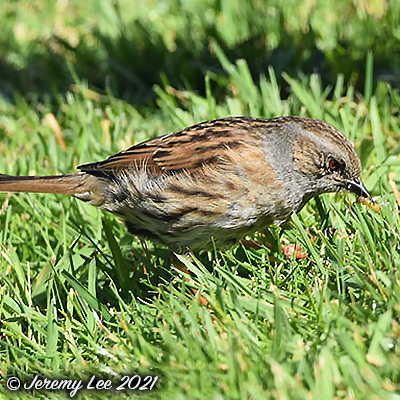
 |
|
Scientific Classifications explained » Amphibians » Ants » Aphids » Bees » Beetles » Birds » Bugs » Butterflies » Caterpillars » Damselflies » Dragonflies » Earwigs » Flies » Frog/Leafhoppers » Fungi » Galls » Grasshoppers » Harvestmen » Hoverflies » Lacewings » Ladybirds » Leaf Mines » Lichens » Mammals » Millipedes » Mosses » Moths » Sawflies » Slugs » Snails » Spiders » Trees & Shrubs » Wasps » Wild Flowers » Woodlice » Postboxes |
UK Nature > Birds > Prunella modularis

Scientific Name: Prunella modularis Common Name: Dunnock Prunella modularis, more commonly known as the Dunnock, is approximately 14cm in length and has a plumage of dull, mottled brown above with greyish head and breast and streaked flanks. Often called a hedge sparrow, probably because of its superficial resemblance to female house sparrows, although the House Sparrow (Passer domesticus) has a much stouter seed-eater's bill and lacks the greyish colouring of the Dunnock. Usually calls a thin, high-pitched "tseep-tseep-tseep", but also has quite a melodious song when required. Their food, consisting mainly of insects, spiders and small seeds, is usually gathered on the ground. Will come to the bird table, but generally prefers to gather scraps that have fallen to the floor below the table. Nest in a cup of twigs, leaves, and other vegetation, lined with hair and moss, built by both sexes in a dense bush or hedge. Found almost anywhere with plenty of cover including heaths, parks and gardens. One of the commonest of our suburban birds and resident throughout the UK. |
|

https://www.uknature.co.uk is a website dedicated to showing the immense diversity of UK nature and wildlife. Our vast range of habitats, from lowland arable to snow covered mountains, from storm-ravaged coastlines to peaceful inland freshwater lakes and rivers, from dry, sandy heaths to deciduous and coniferous forests, all these habitats contribute to the abundance of UK nature. We have wild birds in huge numbers either residing or visiting our shores (597 recorded species as at July 2013) and we must also not forget the humble back garden with its grass lawns, flower beds filled with nectar rich flowers, shrubs and trees, all designed to attract huge numbers of insects such as bees, moths, butterflies and hoverflies; and finally the small ponds which provide safe havens for frogs, toads, newts and even slow worms and grass snakes. www.uknature.co.uk is the showcase for my personal passion, photographing uknature in all its glory. I sincerely hope you all enjoy the fruits of my labours. This site and all images contained therein is © Jeremy Lee 2004 - 2025. All Rights Reserved. Site design by Jeremy Lee. Site development & IT Support by Stuart Lee. |